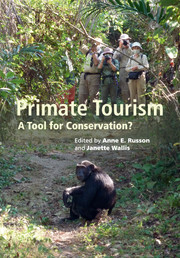Book contents
- Frontmatter
- Contents
- List of contributors
- Part I Introduction
- Part II Asian primates
- 2 Tourism, infant mortality, and stress indicators among Tibetan macaques at Huangshan, China
- 3 Provisioning and tourism in free-ranging Japanese macaques
- 4 Proboscis monkey tourism
- 5 Orangutan tourism and conservation
- 6 The impact of tourism on the behavior of rehabilitated orangutans (Pongo abelii) in Bukit Lawang, North Sumatra, Indonesia
- Part III African primates
- Part IV Neotropical primates
- Part V Broader issues
- Part VI Conclusion
- Index
- References
4 - Proboscis monkey tourism
Can we make it “ecotourism”?
from Part II - Asian primates
Published online by Cambridge University Press: 05 September 2014
- Frontmatter
- Contents
- List of contributors
- Part I Introduction
- Part II Asian primates
- 2 Tourism, infant mortality, and stress indicators among Tibetan macaques at Huangshan, China
- 3 Provisioning and tourism in free-ranging Japanese macaques
- 4 Proboscis monkey tourism
- 5 Orangutan tourism and conservation
- 6 The impact of tourism on the behavior of rehabilitated orangutans (Pongo abelii) in Bukit Lawang, North Sumatra, Indonesia
- Part III African primates
- Part IV Neotropical primates
- Part V Broader issues
- Part VI Conclusion
- Index
- References
Summary
Introduction
Since the 1970s, organizations working for nonhuman primate conservation have emphasized the importance of working with the people in closest contact with nonhuman primates and their forests by attempting to give them a stakeholder share in the benefits of primate preservation and protection (Wetlands, 2001; WWF, 2001). One method for encouraging local protection of nonhuman primates, while maintaining economic balance in the community, is making primates in natural settings a focus for “ecotourism.”
This chapter discusses a case study of primate tourism that focuses on visiting proboscis monkeys (Nasalis larvatus) along the Lower Kinabatangan River in Sabah, Malaysia. The proboscis monkey is an endangered species and a focal species for conservation and tourism in Borneo. The Lower Kinabatangan area is home to proboscis monkeys that have been studied through four PhD projects: Boonratana in 1992, Tadahiro in 2000, Leasor in 2003, and Matsuda in 2005. Tourism has been developing in the area since the mid-1990s. If tourism in this area is to contribute to conserving the area’s natural habitat, proboscis monkeys, and other resident wildlife, then it should operate as ecotourism. It is often promoted as such by the Malaysian Tourism Board. However, numerous signs suggest that much of this tourism does not qualify as legitimate ecotourism.
- Type
- Chapter
- Information
- Primate TourismA Tool for Conservation?, pp. 56 - 75Publisher: Cambridge University PressPrint publication year: 2014
References
- 8
- Cited by



